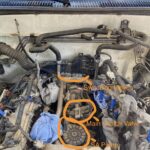Your car’s paint job is more than just a color; it’s a multi-layered shield comprising the body, the base coat, and the clear coat on top. When a scratch goes deeper than just a superficial mark, it can compromise this protective barrier, allowing contaminants to reach the underlying layers and potentially leading to significant damage. Deep scratches are particularly concerning as they penetrate through the clear coat and into the base paint, and in the worst cases, expose the bare metal of your car. Leaving exposed metal untreated is an invitation for rust, which can rapidly escalate from a cosmetic blemish to a structural issue, diminishing your vehicle’s integrity and value. While rust necessitates professional intervention to halt its progression, deep scratches that haven’t reached the metal can often be effectively addressed.
Professional 5-Step Guide to Deep Car Scratch Repair
Repairing deep car scratches demands meticulous attention to detail, mirroring the techniques employed by auto body professionals. By dedicating time and effort, you can achieve near-professional results at home, circumventing costly body shop visits and preserving your car’s aesthetic appeal and resale value. Here’s a step-by-step guide on how professionals tackle deep car scratches:
1. Meticulous Cleaning and Damage Assessment
Professionals always begin with a thorough cleaning of the scratched area. This isn’t just about aesthetics; it’s crucial for preventing further damage. Washing removes dirt, grime, and any loose particles that could exacerbate scratching during the repair process. Professionals use specialized car wash soaps and techniques to ensure a pristine surface. After washing, a careful inspection under good lighting is conducted to accurately assess the depth and extent of the scratch. This assessment determines the appropriate repair strategy and materials needed.
2. Precision Buffing and Compounding Techniques
Buffing is a critical step in a professional scratch repair process. Professionals utilize a range of buffing compounds, from coarser to finer grits, depending on the scratch depth. They often employ rotary or dual-action polishers for controlled and efficient material removal. Starting with a more abrasive compound, professionals gently work the area, focusing on leveling the edges of the scratch with the surrounding clear coat. The key is to remove the minimum clear coat necessary to eliminate the scratch, preserving the paint’s integrity. They work in small, overlapping passes, constantly monitoring the surface and using microfiber cloths to wipe away residue and check progress.
3. Expert Crack Filling with Glazing Putty
For deeper scratches that extend into the base coat, professionals use glazing putty to restore a smooth, even surface. Before applying the putty, they meticulously clean the scratch with isopropyl alcohol to remove any remaining polish or contaminants, ensuring optimal adhesion. Professional-grade glazing putties are chosen for their fine texture, ease of application, and quick curing time. Using specialized applicators like squeegees or palette knives, the putty is carefully applied, filling the scratch precisely and minimizing excess. Professionals are skilled in applying just the right amount of pressure to ensure the putty fills the scratch without creating air pockets or unevenness. Once cured, a paint leveler is used to carefully remove any excess putty, leaving a perfectly flush surface ready for painting.
4. Seamless Touch-Up Paint Application
Achieving a flawless color match is paramount in professional car scratch repair. Professionals use the car’s paint color code to obtain the exact matching touch-up paint. They often employ fine-tipped brushes or airbrushes for precise application, especially in narrow scratches. Multiple thin coats are preferred over a single thick coat to prevent runs and ensure even coverage. Professionals allow ample drying time between coats and for the final coat to cure completely, often using heat lamps to expedite the process and achieve a harder, more durable finish. This meticulous approach ensures the touched-up area blends seamlessly with the original paintwork.
5. Final Buffing and Refinement for a Showroom Finish
The final buffing stage is where professionals elevate the repair from good to exceptional. After the touch-up paint has fully cured, they use very fine polishing compounds and soft foam pads to gently level any minor imperfections and blend the edges of the repaired area with the surrounding paint. This step removes any subtle texture differences and enhances the gloss, creating a uniform and virtually invisible repair. Professionals often finish with a high-quality car wax or sealant to protect the repaired area and enhance the overall shine of the car, ensuring a showroom-quality finish.
Conclusion: Professional Deep Scratch Repair at Your Fingertips
Deep car scratches, while initially alarming, are manageable with the correct techniques and a methodical approach, mirroring professional methods. While severe scratches exposing metal or extensive damage are best left to experienced auto body shops to prevent rust and ensure structural integrity, many deep scratches can be effectively repaired at home using these professional-inspired steps. By investing time and attention to detail, you can confidently restore your car’s finish, preserving its value and appearance, and achieving results that rival professional repairs.

